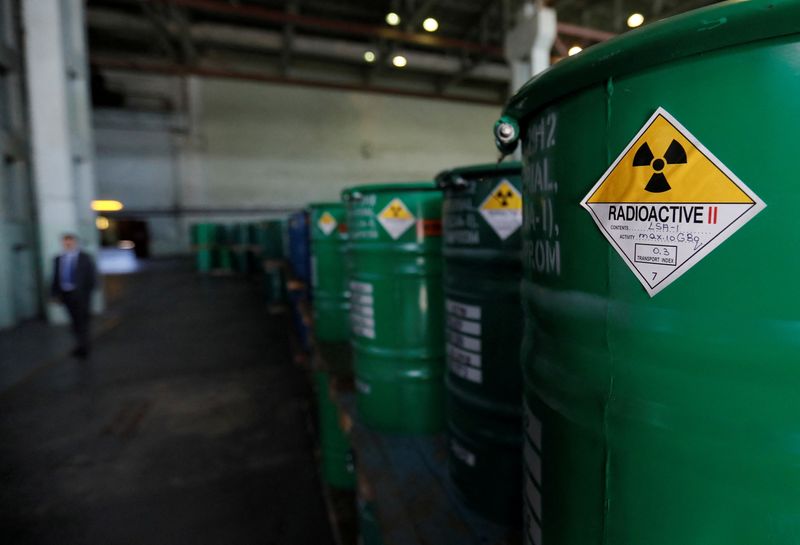By Eric Onstad and Nell Mackenzie
LONDON (Reuters) - Investment banks Goldman Sachs and Macquarie as well as some hedge funds are positioning themselves to reap the benefits of a newly buoyant uranium sector as prices of the nuclear fuel ingredient spike.
While many other investment banks are still avoiding uranium, Goldman and Macquarie are boosting trading in physical uranium and in Goldman's case trading its options as well, five industry and hedge fund sources with knowledge of the deals said.
The heightened activity comes as utilities seek new supplies amid shortfalls that have lifted prices to 16-year highs.
A few hedge funds are also stepping up involvement in both equities and physical uranium, a sign that the metal is starting to broaden its appeal to financial institutions after a decade in the doldrums following the Fukushima nuclear disaster.
"With the headlines and positive momentum in nuclear more generally, hedge funds and other commodity investors are back in the (uranium) sector. A lot of it is done via physical funds, the easiest way to get exposure to uranium prices,” said Bram Vanderelst at trading firm Curzon Uranium.
The metal has captured investors' attention after prices doubled over the past year to $102 a pound as top producers Kazatomprom (LON:KAPq) and Cameco (NYSE:CCJ) cut production guidance because reopened mines that had been mothballed struggled to ramp up production to meet renewed demand.
It also comes with the revival of nuclear energy to help countries cut their carbon emissions, which was highlighted in the December 2023 Group of Seven most industrialised nations' statement that envisioned tripling nuclear energy capacity from 2020 to 2050.
Goldman Sachs has started writing options on physical uranium for hedge funds, the first time it has created a derivative for the metal.
"Goldman has been increasing their visibility, they've been increasing their book steadily," a source who dealt with the bank said, declining to give details of the transactions because they are confidential.
Goldman is largely dealing with financial clients like hedge funds while Macquarie's main focus is boosting trading and marketing output from miners, another source who dealt with both banks said, also declining to elaborate because the data is confidential.
All five sources Reuters spoke to declined to be named because they did not want to discuss publicly private trading details.
Both banks declined to comment.
NUFCOR'S URANIUM INVENTORIES
Goldman has been involved in the uranium market since 2009, when it bought Nufcor, a London-based nuclear fuel trader.
Five years later, however, in the wake of Japan's Fukushima nuclear plant disaster in 2011 when uranium prices plummeted, Goldman aimed to offload Nufcor, but was unable to find a buyer and said it planned to wind down the business.
The business never closed and Nufcor held $356 million worth of uranium inventories at the end of 2022, the most recent regulatory filings showed.
That is enough uranium to fuel 17 large nuclear reactors for a year, based on Reuters calculations and data from the World Nuclear Association.
Investor buying of physical uranium by publicly-traded funds and hedge funds represented nearly 15 million pounds of uranium oxide concentrate (U3O8), or about 26% of the total traded on the spot market in 2023, according to consultancy UxC.
This was down from 22 million pounds of investor buying in 2022 as higher prices in 2023 meant each dollar bought fewer pounds of uranium.
"We’ve especially seen large volumes purchased by investors in 2021-2023," said Jonathan Hinze, president of UxC.
See factbox.
U3O8 or yellowcake is a fine powder packaged in steel drums that is produced when uranium ore is chemically processed.
While the biggest amount of investor-held physical uranium is by exchange-listed funds, a few hedge funds have been investing in shares of uranium miners and other nuclear-related firms for several years and are also now investing in physical uranium.
Sachem Cove Partners, a uranium-focused investment strategy with about $250 million in assets under management, started investing in the sector in 2018 with equities and proxies for physical uranium, like the Sprott Physical Uranium Trust.
It began buying physical uranium last year.

"It gives us a look into both markets, the physical market
itself and the equity markets," said Mike Alkin, chief investment officer.